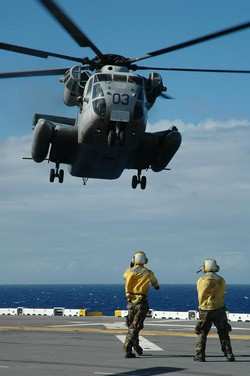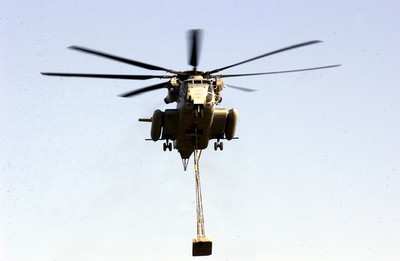$20 Million Center Will Produce Dynamic Major Components
 Sikorsky formally opened its new
Precision Components Technology Center Friday, launching a new path
toward strategic competitive excellence beginning with the
manufacture of CH-53K heavy lift helicopter components.
Sikorsky formally opened its new
Precision Components Technology Center Friday, launching a new path
toward strategic competitive excellence beginning with the
manufacture of CH-53K heavy lift helicopter components.
The center will produce major dynamic components of the CH-53K
helicopter such as rotating and stationary swashplates, main and
tail rotor hubs, and main rotor sleeves. It will showcase the
magnitude of the CH-53K helicopter and the unique production
challenges presented by its size and technological complexity.
Forgings to be machined in the center, for example, will be twice
the size of the largest forging produced at the facility to
date.
Of UTC's total investment of $130 million in the program,
Sikorsky has committed more than $20 million to the Precision
Components Technology Center.
 "Sikorsky's investment in this new technology center is
further evidence of the company's commitment to the CH-53K
helicopter program," said Mark Cherry, Vice President, Marine Corps
Programs. "The heavy lift mission is critical; the size and
complexity of the CH-53K helicopter's critical parts necessitated a
center dedicated to its production and design iterations as we
continue on our path to first flight. We expect the technology
center to leverage a number of the manufacturing improvements
incorporated in the development of this aircraft, including
identifying critical part characteristics to align with
manufacturing process capability."
"Sikorsky's investment in this new technology center is
further evidence of the company's commitment to the CH-53K
helicopter program," said Mark Cherry, Vice President, Marine Corps
Programs. "The heavy lift mission is critical; the size and
complexity of the CH-53K helicopter's critical parts necessitated a
center dedicated to its production and design iterations as we
continue on our path to first flight. We expect the technology
center to leverage a number of the manufacturing improvements
incorporated in the development of this aircraft, including
identifying critical part characteristics to align with
manufacturing process capability."
The center currently employs eight.
The Precision Components Technology Center was designed to allow
the development of new product lines with "zero setup time" and
quick changeover from one component to another. The equipment in
the center has the capability to produce any precision rotor and
drive system dynamic component including legacy configurations.
Mick Maurer, Senior Vice President of Sikorsky Operations, said
the center's primary focus will be to support the dynamic
components of the CH-53K System Development and Demonstration
program, but the facility also was created with an eye toward the
future.
"The grand opening of the Precision Components Technology Center
marks a significant program milestone that demonstrates our
commitment to the U.S. Marine Corps and the development of the next
generation CH-53K heavy lift helicopter. As we expand our
global footprint, Sikorsky continues to invest in state-of-the-art
manufacturing capabilities that offer a unique competitive
advantage in the advancement of flight-critical dynamic component
technologies," Maurer said.
Sikorsky Aircraft received a $3 billion System Development and
Demonstration contract on April 5, 2006 to develop a replacement
for the U.S. Marine Corps CH-53E heavy lift helicopter. The new
aircraft program is planned to include production of more than 200
new aircraft. Development money and production quantities will be
determined year-by-year over the life of the program based on
funding allocations set by Congress and Pentagon acquisition
priorities.
Its predecessor, the three-engine Sikorsky CH-53E SUPER STALLION
helicopter, is the largest, most powerful marinized helicopter in
the world. It is deployed from Marine Corps amphibious assault
ships and land bases to transport personnel and equipment and to
carry external (sling) cargo loads.
The CH-53K helicopter will maintain virtually the same footprint
as the CH-53E aircraft, but will nearly triple the payload to
27,000 pounds over 110 nautical miles under "hot high" ambient
conditions. The CH-53K helicopter's maximum gross weight (MGW) with
internal loads is 74,000 pounds compared to 69,750 pounds for the
CH-53E aircraft. The CH-53K helicopter's MGW with external loads is
88,000 pounds as compared to 73,500 for the CH-53E helicopter.

Features of the CH-53K helicopter include: a joint interoperable
glass cockpit; fly-by-wire flight controls; fourth generation rotor
blades with anhedral tips; a low-maintenance elastomeric rotor
head; upgraded engines; a locking cargo rail system; external cargo
handling improvements; survivability enhancements; and reduced
operation and support costs.
 NTSB Final Report: Cozy Cub
NTSB Final Report: Cozy Cub ANN FAQ: Contributing To Aero-TV
ANN FAQ: Contributing To Aero-TV Classic Aero-TV: Seated On The Edge Of Forever -- A PPC's Bird's Eye View
Classic Aero-TV: Seated On The Edge Of Forever -- A PPC's Bird's Eye View ANN's Daily Aero-Linx (04.29.25)
ANN's Daily Aero-Linx (04.29.25) ANN's Daily Aero-Term (04.29.25): Execute Missed Approach
ANN's Daily Aero-Term (04.29.25): Execute Missed Approach




